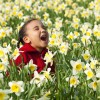9 April Crafts and Books for Earth Day, Easter and 'Día del Niño'

Celebrate April as a family with Earth Day activities, Easter egg games and books to read for "Día del Niño," Mexico's Day of the Child.
Celebrate Earth Day
We celebrate Earth Day on April 22 to support protecting the planet from things like pollution, deforestation and climate change. This international event was first celebrated in 1970 and led to the creation of the Environmental Protection Agency. More than 50 years later, we still celebrate Earth Day to remind each other to be responsible stewards of our planet.
Try some of these activities with your child to show how they can make our world a better place to live.
Reuse Empty Toilet Paper Rolls to Make Maracas
Make and decorate musical maracas using two recycled toilet paper rolls, dried beans, tape, and markers! Making these maracas with your little one is a fun way to explore a new musical instrument and practice different math concepts. Practice the early math concepts of number sense, counting and making patterns with this maraca-making activity.
Grow an Edible Plant and Measure Its Growth
Gardening gets kids excited to see seeds sprout and grow into plants. Growing edible plants also helps kids learn how to grow their own food, which can teach them about not wasting it.
Bean seeds are relatively simple to grow. Fill a plastic cup most of the way with soil and plant two to three beans. Then, cover the beans gently with a layer of soil. Have children moisten the soil with a spray bottle filled with water.
Chart the beans' growth together over the course of a few weeks. You can make a science observation journal by folding five pieces of paper in half together and stapling the fold to make a book. Check every few days to see how the plants have grown. For each entry, write that day’s date, the plant's height and draw a picture of it. Use a ruler to measure how tall the plant is. Centimeters are best to measure growth. Have your child make a drawing of the plant or take photos for a digital science observation journal!
Bowl With Recycled Cans and Bottles
Reducing the amount of waste we create, reusing everyday materials and recycling materials that can be made into new things are important Earth Day themes. You can reinforce the idea of reusing by digging through your recycling bin for materials that inspire kids to make new projects like making piñatas and robots out of old boxes. For example, try a fun outdoor game of bowling! Create a game of recycled bottle bowling by gathering 10 plastic bottles and cans. Line them up in triangle shape in decreasing rows from four to one and roll a ball to knock them down!
Have Fun With Easter Eggs
Decorating and collecting Easter eggs is a fun part of celebrating Easter for kids. The tradition of dyeing and decorating Easter eggs goes as far back as the 13th century and Easter egg decorations look different all over the world. In some countries, like Ukraine, eggs are covered in intricate, symmetrical decorations using beeswax and die. In some Latin American countries, families make "cascarones" for Easter, which are chicken eggs that are emptied and dried, then stuffed with confetti and resealed with tissue paper. Try some of these Easter egg activities with your little one that incorporate early math concepts.
Easter Egg Sort
Create a fun sorting game for your little ones using Easter eggs! Sorting means to organize items into groups (also called sets) based on attributes and is an important early math skill.
- Start by gathering together all kinds of egg-shaped objects around your house. You can collect objects like plastic Easter eggs, footballs, chocolate eggs, marbles and lemons.
- Set out four or more bins for your child to sort the eggs into. Ways to sort the “eggs” can be size, texture, weight, shape or color.
- Alternatively, you can use plastic eggs only and fill them with different “mystery materials” like beans, tissue paper, cotton balls and marbles. Your little ones can sort the plastic eggs based on color, sound, weight or even based on their guess of what the mystery material is!
Inspired by Mamaguru's 4 Preeschool Math Activities Using Easter Eggs.
Pattern Egg Decorations
In some countries like Sweden, Norway, Poland and Germany, eggs are used to make festive tree decorations. Create an Easter egg tree of your own using plastic easter eggs, ribbon or yarn and decorations!
- Identify the tree you will decorate. If you have a tree around your house to decorate, that’s great! However, you don’t need a real tree to do this activity. You can also hang Easter eggs on a hanger to make an egg mobile.
- Gather plastic eggs in various colors. Decorate the eggs in different colorful patterns with paint or sequins and glue. Start by making a pattern on one of the eggs for your child to copy. Then ask them to continue to pattern on the rest of the egg by asking, “What comes next?” For example, you can decorate your eggs with patterns in rows of alternating sequin colors, like green, green, purple, purple. Be sure not to glue anything on top of the line where the two halves of the egg snap together, since you will need to open the egg for the next part of the activity.
- To hang the eggs, cut a piece of yarn or ribbon to be around six inches long. Next, open the eggs and place the two ends of the ribbon or yarn inside. The middle portion of the yarn should be outside of the egg (this is the part that will hang from the tree). Test the eggs to see how well they hang. You may need to tape the ends to the inside of the egg or tie a small knot at each end so it won't slip out.
- Hang the eggs on the lower branches of a tree. Space out the eggs to give the tree a fuller appearance. Enjoy your beautifully decorated patterned egg tree!
Celebrate 'Día del Niño'
"Día del Niño" (Day of the Child) is a celebration of childhood, and in the U.S., literacy as well. In Mexico, Día del Niño is celebrated on April 30. Teachers help make it a special day by bringing games, music and food to their classrooms. In the United States, an increasing number of cities and schools are celebrating as well. In 1997, poet and author Pat Mora advocated for this day to become a family-focused literacy initiative in the United States called “El día de los niños/El día de los libros" (Children's Day/Book Day), or “Día” for short.
Here is a list of books about literacy for Día del Niño to read with your little one:
- "Book Fiesta!: Celebrate Children's Day/Book Day - Celebremos El dia de los ninos/El dia de los libros" (Ages 4-8)
Written by Pat Mora and illustrated by Rafael Lopez.
This bilingual book is about the history of Children's Day/Book Day.
- "Book Uncle and Me" (Ages 7-10)
Written by Uma Krishnaswami and illustrated by Julianna Swaney
This book is about how kids can make a difference in their communities with a love of books.
- "Waiting for the Biblioburro/Esperando El Biblioburro" (Ages 5-8)
Written by Monica Brown and illustrated by John Parra
This bilingual book tells the story of a real-life librarian named Luis Soriano who brought a mobile library to children living in rural Columbia.
- "Sembrando Historias: Pura Belpré bibliotecaria y narradora de cuentos/Planting Stories: The Life of Librarian and Storyteller Pura Belpré" (Ages 4-8)
Written by Anika Aldamuy Denise and illustrated by Paola Escobar
The story of the first Puerto Rican librarian in New York City named Pura Belpré, who championed bilingual books.
After reading together, make a reading log to help your little one see their growing reading accomplishments! You can make a reading log using a piece of lined paper with three columns including the date, the name of the book and the number of pages you read together. Count how many pages you read together in each sitting by using subtraction. You can use the formula of (last page number read) minus (first page number read) = number of pages read.





